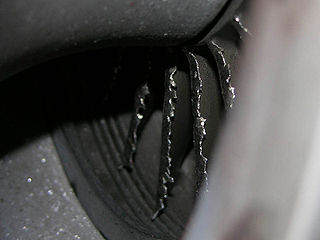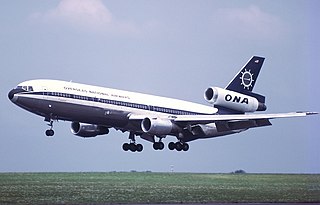
The Boeing 777, commonly referred to as the Triple Seven, is an American long-range wide-body airliner developed and manufactured by Boeing Commercial Airplanes. The 777 is the world's largest twinjet and the most-built wide-body airliner. The jetliner was designed to bridge the gap between Boeing's other wide body airplanes, the twin-engined 767 and quad-engined 747, and to replace aging DC-10 and L-1011 trijets. Developed in consultation with eight major airlines, the 777 program was launched in October 1990, with an order from United Airlines. The prototype was rolled out in April 1994, and first flew in June. The 777 entered service with the launch operator United Airlines in June 1995. Longer-range variants were launched in 2000, and first delivered in 2004.

The Boeing 757 is an American narrow-body airliner designed and built by Boeing Commercial Airplanes. The then-named 7N7, a twinjet successor for the trijet 727, received its first orders in August 1978. The prototype completed its maiden flight on February 19, 1982, and it was FAA certified on December 21, 1982. Eastern Air Lines placed the initial 757-200 variant in commercial service on January 1, 1983. A package freighter (PF) variant entered service in September 1987 and a combi model in September 1988. The stretched 757-300 was launched in September 1996 and began service in March 1999. After 1,050 had been built for 54 customers, production ended in October 2004, while Boeing offered the largest 737 NG variants as a successor.
Kalitta Air is an American cargo airline headquartered at Willow Run Airport, Ypsilanti Township, Michigan. The company operates international scheduled and cargo charter services. Its call sign "Connie" is from its founder, Connie Kalitta.

The Boeing 787 Dreamliner is an American wide-body jet airliner developed and manufactured by Boeing Commercial Airplanes. After dropping its unconventional Sonic Cruiser project, Boeing announced the conventional 7E7 on January 29, 2003, which focused largely on efficiency. The program was launched on April 26, 2004, with an order for 50 aircraft from All Nippon Airways (ANA), targeting a 2008 introduction. On July 8, 2007, a prototype 787 was rolled out without major operating systems, and then the aircraft experienced multiple delays until its maiden flight on December 15, 2009. Type certification was received in August 2011 and the first 787-8 was delivered in September 2011 before entering commercial service on October 26, 2011, with ANA.

Aviation safety is the study and practice of managing risks in aviation. This includes preventing aviation accidents and incidents through research, educating air travel personnel, passengers and the general public, as well as the design of aircraft and aviation infrastructure. The aviation industry is subject to significant regulation and oversight.

In aviation and aerospace, the term foreign object damage (FOD) refers to any damage to an aircraft attributed to foreign object debris, which is any particle or substance, alien to an aircraft or system which could potentially cause damage to it.

A bird strike is a collision between an airborne animal and a moving vehicle. The term is also used for bird deaths resulting from collisions with structures, such as power lines, towers and wind turbines.

An airplane, or aeroplane, informally plane, is a fixed-wing aircraft that is propelled forward by thrust from a jet engine, propeller, or rocket engine. Airplanes come in a variety of sizes, shapes, and wing configurations. The broad spectrum of uses for airplanes includes recreation, transportation of goods and people, military, and research. Worldwide, commercial aviation transports more than four billion passengers annually on airliners and transports more than 200 billion tonne-kilometers of cargo annually, which is less than 1% of the world's cargo movement. Most airplanes are flown by a pilot on board the aircraft, but some are designed to be remotely or computer-controlled such as drones.

The Eclipse 500 is a very light jet (VLJ) originally produced by Eclipse Aviation of Albuquerque, New Mexico, United States. The company was founded in 1998 to develop the 1997 Williams V-Jet II demonstrator. The prototype first flew with Williams EJ22 turbofans on August 26, 2002. The engines were replaced by Pratt & Whitney Canada PW610Fs in 2004 and Eclipse Aviation won the Collier Trophy in February 2006 for the design. A provisional FAA type certification was received on 27 July 2006 and the first delivery occurred on 31 December 2006.

Arnold Air Force Base is a United States Air Force base located in Coffee and Franklin counties, Tennessee, adjacent to the city of Tullahoma. It is named for General Henry "Hap" Arnold, the father of the U.S. Air Force.

United Air Lines Flight 297 was a scheduled flight from Newark International Airport to Atlanta that crashed 10 miles (16 km) southwest of Baltimore on November 23, 1962, killing all 17 people on board. An investigation concluded that the aircraft, a Vickers Viscount 745D turboprop airliner, had struck at least two whistling swans, which caused severe damage to the plane, resulting in a loss of control.

The DARPA FALCON Project is a two-part joint project between the Defense Advanced Research Projects Agency (DARPA) and the United States Air Force (USAF) and is part of Prompt Global Strike. The first part of the project aims to develop a Small Launch System (SLS) capable of accelerating hypersonic gliding weapons as well as launching small satellites into Earth orbit. The second part of the project aims to develop Hypersonic Weapon Systems (HWS): a short term high performance hypersonic gliding weapon previously named the X-41 Common Aero Vehicle (CAV) that could be launched from Expandable Launch Vehicles (ELV), Reusable Launch Vehicles (RLVs), Hypersonic Cruise Vehicles (HCV), or Space Maneuvering Vehicles (SMP), and a long term hypersonic cruise aircraft named the Hypersonic Cruise Vehicle (HCV). This two-part program was announced in 2003 and continued into 2006.

US Airways Flight 1549 was a regularly scheduled US Airways flight from New York City, to Charlotte and Seattle, in the United States. On January 15, 2009, the Airbus A320 serving the flight struck a flock of birds shortly after takeoff from LaGuardia, losing all engine power. Given their position in relation to the available airports and their low altitude, pilots Chesley "Sully" Sullenberger and Jeffrey Skiles decided to glide the plane to ditching in the Hudson River off Midtown Manhattan. All 155 people on board were rescued by nearby boats, with only a few serious injuries. The time from the bird strike to the ditching was less than four minutes.
AEDC Ballistic Range S-3 is a single stage air gun owned by the United States Air Force. The gun is commonly used for bird strike testing and is often called a chicken gun.

On February 26, 1973, a private Learjet 24 crashed shortly after take-off from DeKalb–Peachtree Airport in Chamblee, Georgia, United States. The aircraft, registration N454RN, owned by a private corporation, struck birds shortly after lifting off. Air traffic control advised the flight crew of smoke trailing from their left engine; the crew said they would not be able to return to the airport. The aircraft impacted the roof of an apartment building and came to rest in a ravine. All five passengers and two crew members aboard the aircraft were killed; a person in the apartment building suffered severe burns.

The Airbus A320neo family is an incremental development of the A320 family of narrow-body airliners produced by Airbus. The A320neo family is based on the previous A319, A320, and A321, which was then renamed A320ceo, for "current engine option".

A testbed aircraft is an aeroplane, helicopter or other kind of aircraft intended for flight research or testing the aircraft concepts or on-board equipment. These could be specially designed or modified from serial production aircraft.
Many aviation-related events took place in 2020. The aviation industry was impacted by the onset of the COVID-19 pandemic.

Kalitta Air Flight 207 (K4207/CKS207) was a scheduled cargo flight between John F. Kennedy Airport to Bahrain International Airport with a technical stopover at Brussels. On May 25, 2008, the Boeing 747-200 overran runway 20 during takeoff at Brussels Airport, causing the aircraft to split into three large pieces. The occupants sustained minor injuries.

Overseas National Airways (ONA) Flight 032 was a non-scheduled positioning flight operated by Overseas National Airways with a McDonnell Douglas DC-10-30CF. On November 12, 1975, the flight crew initiated a rejected takeoff after accelerating through a large flock of gulls at John F. Kennedy International Airport, resulting in a runway excursion. Of the 139 aircraft occupants, all survived, while the aircraft was destroyed by an intense post-crash fire. The National Transportation Safety Board concluded that the probable cause of the accident was bird ingestion into the right-hand engine, causing an uncontained engine failure that ruptured several landing gear tires and disabled the engine's hydraulic system, in turn partially disabling the spoilers and the landing gear brakes. Contributing to the accident was the resultant failure of the affected engine's thrust reverser and the wet runway. The accident aircraft is claimed to be the largest commercial airliner ever destroyed due to a bird strike.


















